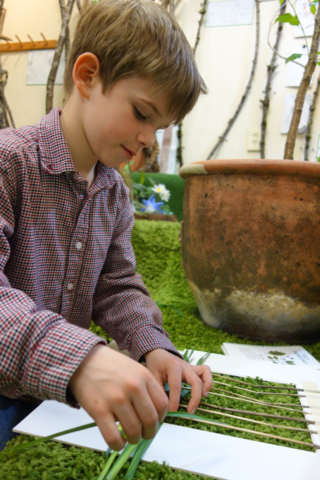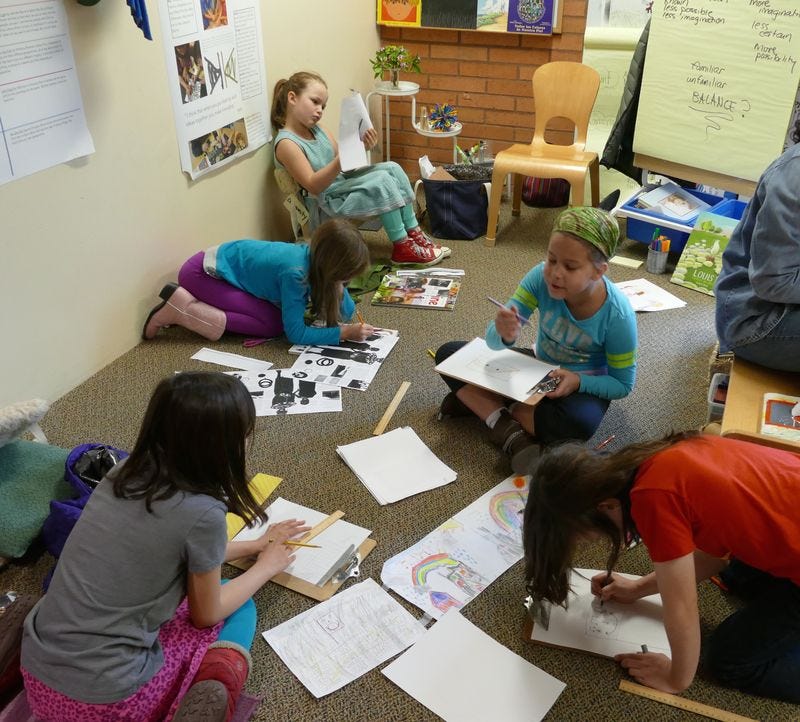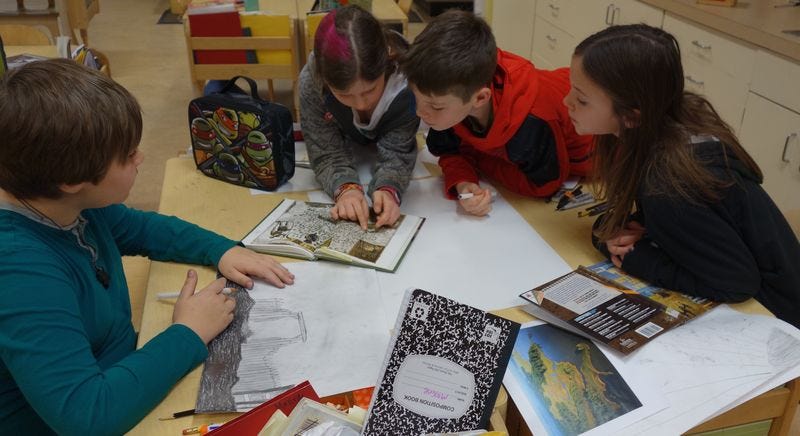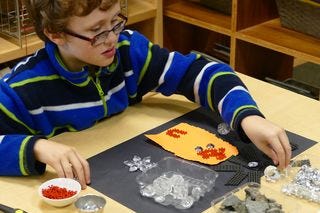Why Should We Get Rid of the Arts in Schools?
In these times, when the demolition of a place as celebrated as Sesame Street can exist thwarted by editing for shorter attention spans and conversion to pay-per-view, it can exist difficult to retrieve what all the fuss was about during the height of the Civilisation Wars. In these times, it'southward easy to assume that the growing absenteeism of the arts and play in schools is one of fourth dimension pressures and competing priorities and disagreements near how children learn, and unrelated to a struggle for cultural command. Arts programs are being stripped from schools, especially schools serving our most vulnerable neighborhoods, because those schools are choosing, in response to a diversity of policy decisions, to spend more than time on subjects more likely to raise scores on standardized tests.
Considering we've got to business concern ourselves with a Common Core, correct? Surely it is in everyone's best interest to focus on that?

Regardless of the respond to those questions, what must be clear is that we are in the midst of a savage fight to control the story that frames the world we live in equally American citizens. Equally any policy maker or political candidate knows, who controls the culture controls the story. There is no better way — really, no otherway — to command civilization, than to control admission to the arts.
In their Culture of Inventiveness report, the LEGO Foundation synthesizes the work of xviii essayists from around the world, commissioned to write nigh creativity informed past the perspective of their own culture. In summary, they write, "Culture is … a arrangement through which people build meanings, and develop customs, through the dimensions of having, doing, being and knowing. These are driven by playing, sharing, making and thinking — the agile processes through which people acquire and form meanings together."
What is eliminated from our classrooms when we eliminate the arts is playing, sharing, making and thinking.
What is alienated from our classrooms is the opportunity to practice playing, sharing, making and thinking — without which it becomes impossible (or very difficult) to brand meaning of our experience with the world. Without practice in the arts, we take less ability to reverberate on our experience, to ask good questions, to express our perspective, to human activity on our feelings, to develop a community that might resist the condition quo. If you tin can control the culture, y'all can control the story. And as long every bit your version is right, and so alternatives can be, but, wrong.
Restricting access to the arts allows those who wish to control the story to ensure that they are right and others are incorrect. This feeling of being right empowers them to crave obedience and sanctions a diverseness of punishments for defiance — from expulsion in preschool to retention in 2d grade to defunding schools who don't pass tests to execution in the street in wide daylight. Fear of beingness wrong keeps people focused on being right instead of asking what's right.
Fright decreases collaboration, listening, and ultimately, snuffs out empathy. Fearful people will fall in line behind a dictator.
Restricting access to the arts enforces silence by criminalizing creative disobedience. Increasingly, restricted admission to the arts has grown an adult accomplice that tolerates poisoned drinking water when a governor is responsible only calls other such violence, fifty-fifty when at that place are far fewer victims, an act of terror if ISIS is involved. Restricting the practice of playing, making, sharing, and thinking during the fourth dimension when our youngest citizens' brains are growing has created a society of adults that cannot tolerate ambiguity, cannot think critically, are fearful, and are drawn to radical political rhetoric.

So, these days, I wonder if the trouble of the arts in schools is because of the human relationship between the arts and learning. Since the Reagan assistants created policies that led to large decreases in funding to the National Endowment for the Arts as belatedly as 1997, the yr in which the civil-rights-inspired Expansion Arts Program was discontinued, the effect has been that fewer artists are confronting issues that challenge the status quo. Fewer people are playing, sharing, making and thinking.
Dudley Cocke of Roadside Theater writes, "Well-nigh problematically, without federal support national conversations about culture policy began to evaporate, and in the void nonprofits hunkered down to fight for their ain." In our public schools and in our non-turn a profit organizations, fewer people are playing, sharing, making and thinking. And that means that fewer people are contributing to the development of what we experience as American culture.
Schools without art mean that fewer children discover the ability of their own potential for expression.
And that ways that over time fewer voices are contributing because fewer people believe that they take something to contribute. Fewer people believe they have a correct or a reason to contribute. And as creative capacity is diminished, capitalism eagerly fills the void.

From Disney to McDonald'south to Sponge Bob to Big Bird, commercial culture has increasingly replaced or been confused with creativity. And while their children are delighted, adults are distracted from the problem at hand.
Commercial civilization has led adults, for case, to focus on how the arts can be leveraged for other tasks — similar how music improves math — rather than on the cultural impact of cutting the arts from our environments for learning. In his article Art and Commonwealth, Cocke writes, "the impact of U.S. commercial civilisation in this moment of globalization has get overwhelming. Imagine how the U.S. looks to hundreds of millions of people around the globe whose only sources of information well-nigh u.s.a. are commercial or propaganda television, Hollywood movies, and pop music. Equally troubling, at domicile this commercial preference has corrupted our own not-for-profit sectors' core values." Information technology has been more than a decade since this article was published, and we can encounter the the impact. Commercial culture has functioned as a sleight of hand, obscuring the distinction betwixt creator and consumer, seducing us into an acceptance of conformity and loss of identity, and handing us the politics of the twenty-four hours.

One function of the NEA'due south original purpose statement reads, "Democracy demands wisdom and vision in its citizens and must therefore foster and support a course of education designed to brand men masters of their engineering and non its unthinking servant." As funding for the arts has been cut, these ideas have been diluted. As economic disparities have grown, creative disparities have grown aslope them. When the children of parents who can pay $38,000 a twelvemonth for preschool are told by school founder Chris Wink, "This much is sure: it will exist impossible to convince [our] children that their aspirations are unattainable. …There will be no way of fooling them into believing that the stirrings in their hearts are unimportant." And David Coleman, the architect of Common Core, is telling the children down the street at the neighborhood public school that "people don't really give a **** near what you feel or what you lot think", it's long past time to consider the implications of such a serious threat to our commonwealth. The question remains: what are we willing to do about it? How will we find our way?
The authors of the LEGO Foundation's Civilisation of Inventiveness study write, "cultures are made past humans, but culture also significantly shapes immature children, considering the man race is amazingly adaptive, particularly in the critical young years." It is precisely because the young human is and then amazingly adaptive that finding means to infuse the arts into the daily life of the classroom may exist the greatest subversive tool we accept to combat the commercialized, controlled, and combative civilisation that will otherwise shape our children. Playing, making, sharing, and thinking are the birthright of our species and natural learning strategies that all children bring with them to school. Children arrive at school with a creative mindset. What experiences and environments tin can adults blueprint to sustain and extend it?

I don't consider myself to be an artist, or an art teacher. Notwithstanding, when I am instruction in the classroom, it is my habit to ask myself, "Where are the arts?" I notice that when I habitually ask that question every bit I'one thousand planning, the arts become habitual. The availability of tools of the arts, every bit well as an invitation to utilise them, secures my role as "professional marveller" as Loris Malaguzzi, founder of the municipal preprimary schools in Reggio Emilia, Italy, fondly described the piece of work of the teacher. Similar the day several weeks ago, when 8 year-old Ella wondered aloud during a whole grouping dialogue in response to a book I'd read to them, "I know that metacognition means thinking about your thinking. But what'southward the give-and-take that means thinking about your feelings?" The excited hush that typically follows such a beautiful question ran through the group. What is that word? And how might those words be related? How are thinking and feeling related? Which comes first? Can you have one without the other?
So I invited the children to PLAY with the idea. Using collections of loose part materials for collage or building, I invited them to MAKE a theory and to SHARE it with a partner. And it wasn't likewise long before viii twelvemonth-old KD ran excitedly to me and said she'd been just fiddling around with a shiny piece of tinsel in the light when she fabricated a discovery. She explained, "It all started out with a shiny piece. Its shadow reflected on the table. Like in Buddy and Earl,[Buddy] idea nearly his feelings and he felt his feelings of beingness friends. Yous think well-nigh your thinking and y'all feel and yous feel and you lot think — it goes back and forth like the reflection in a mirror. It'southward reflection!"
I don't need to be an artist to offer children use of the materials of the arts every bit tools for thinking. And that'south not to diminish the value of artists in the schools or children'south encounters with artists who can teach and apprentice them, offering inspiration and skill and technique that they have a right to just as much as they have the right to multiplication tables or internet research. It'south just to say that I tin can choose to proceed the door open. And when I exercise, they retain access to their creative birthright. They practice influencing the culture of their classroom community with their ideas and feelings and questions and contributions. They discover out they can.

More of the NEA's purpose statement reads, "The practice of art and the study of the humanities crave constant dedication and devotion and . . . it is necessary and appropriate for the Federal Authorities to help create and sustain not only a climate encouraging freedom of thought, imagination, and inquiry, but too the material conditions facilitating the release of this creative talent." We are now reaping the results of a dedication and devotion to commercialism and consumerism.
If we are to evolve beyond a civilisation that confuses adolescent posturing with political debate, nosotros'll need to offer our youngest citizens a climate encouraging freedom of thought, imagination and inquiry. Nosotros'll need to grow a new kind of citizenry. And that means we'll need to invest in the material conditions that will facilitate the release of every kid's inherent creative talent. Because it is only when our youngest citizens practice knowing how to limited such freedoms in the company of others who have the right to exercise the same, that our culture volition evolve to one that tin tolerate the incertitude inherent in diversity — a civilisation that is courageous almost addressing the issues that come with trying to thrive equally an individual in the midst of a thriving, vibrant and loving society — the one that we made together.
Bio: Susan Harris MacKay's work showtime appeared on the Living in Dialogue blogand the appeared on the Opal School Web log.
Source: https://www.ashoka.org/en/story/why-we-don%E2%80%99t-do-art-school-and-why-we-should
0 Response to "Why Should We Get Rid of the Arts in Schools?"
Post a Comment